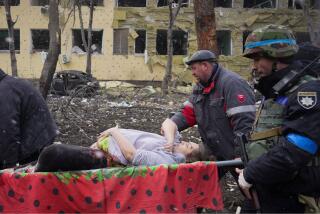On Lint, a Tale of a War Orphan’s Rescue
- Share via
Prior to systems of mechanical and electronic reproduction, war and human tragedy were the stuff of epic poetry, spoken or sung. Today they’re communicated daily through newspapers and television networks.
In a new narrative work at the Santa Monica Museum of Art, Mary Kelly rubs the genres of poetry and mass media against each other but generates few illuminating sparks.
“The Ballad of Kastriot Rexhepi” tells the story of an 18-month-old war orphan child in Kosovo, who was left for dead in the woods by his young mother but miraculously survived; compounding the marvel, the little boy was reunited with his family some months later.
Kelly’s song of loss and reunion, based on a July 1999 story in The Times by reporter Scott Glover and photographer Ami Vitale, unfolds in some 40 text panels that ring the gallery. The narrative takes the form of metered prose.
“Unnatural spring,” begins the text, marshaling familiar metaphors of violent weaponry, “metal seedpods, germinating bloody flora, anticipating the ‘expulsions.’” A desperate young Albanian family fleeing the chaos of combat between the rebel Kosovo Liberation Army and Serbian paramilitaries leaves behind young Kastriot, thought to have died of starvation. Found alive by Serbian police officers, the unidentified boy is taken to a hospital in Pristina, given a new name and ethnic identity and nursed back to health. Through the hunch of a doctor, who has heard of a family in a nearby village who had lost a child in the war, a reunion is arranged.
The story of a single family stands in for the larger narrative of an established social order rent by violence and then nominally restored. Identity is fluid and constantly shifting in the wrenching saga, but finally not much change occurs. “Bab,” murmurs the “resurrected” boy upon seeing his once-lost father; the word, Albanian slang for Dad, gives Kelly the final wry but dramatic exclamation for her text.
Kelly’s piece, like an earlier work from 1999, is made from compressed lint gathered from the lint trap of a home dryer. According to an unrelated story in The Times, one anti-terrorist consultant advises embassy personnel in war-torn countries to keep sandwich bags of dryer lint in their survival backpacks--it’s great tinder for an emergency campfire--but that doesn’t seem to be the allusion here. Instead, its status as filtered residue is.
Flat, curved sections laid end to end form an elegant gray image of a regular, undulating sound wave that encircles the room. The relatively brief text is printed in shallow relief as a straight, continuous through-line. The fuzzy, filtered lint creates an oddly photographic appearance.
Mostly, though, “The Ballad of Kastriot Rexhepi” reshuffles artistic conventions whose familiarity during the past 30 years muffles curiosity. The elimination of color in favor of black and white is a conventional signifier of the elevation of orderly intellect and the suppression of unruly senses. The use of domestic material such as dryer lint is a conventional signifier of a feminist framework. A filter is a conventional signifier for mediation of experience. Family trauma is a conventional signifier of psychoanalytic interpretation. Reading text while standing up in an art gallery is a conventional signifier of moral seriousness.
Informed but dull, this slight work only appears to be fluid. As with the harrowing story it tells, actual change eludes academic art.
A videotape of an independent performance of a score for the ballad, composed by Michael Nyman and sung by Sarah Leonard, will be shown in an adjacent gallery.
*
“Mary Kelly: The Ballad of Kastriot Rexhepi,” Santa Monica Museum of Art, Bergamot Station, 2525 Michigan Ave., (310) 586-6488, through Jan. 20. Closed Mondays.
More to Read
The biggest entertainment stories
Get our big stories about Hollywood, film, television, music, arts, culture and more right in your inbox as soon as they publish.
You may occasionally receive promotional content from the Los Angeles Times.











